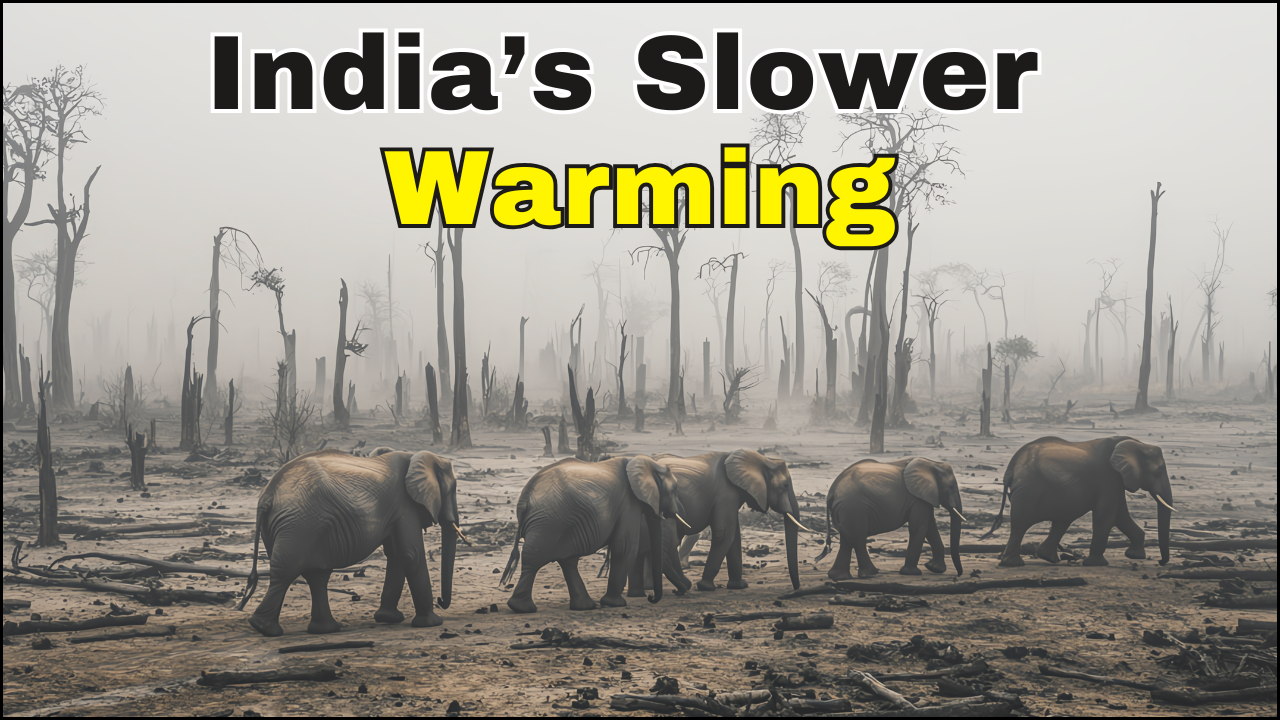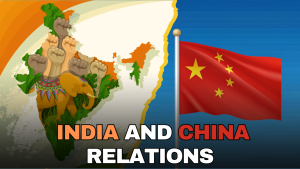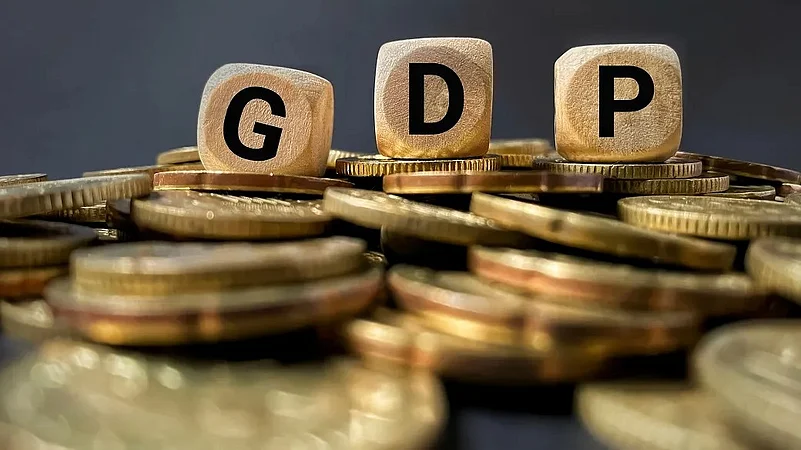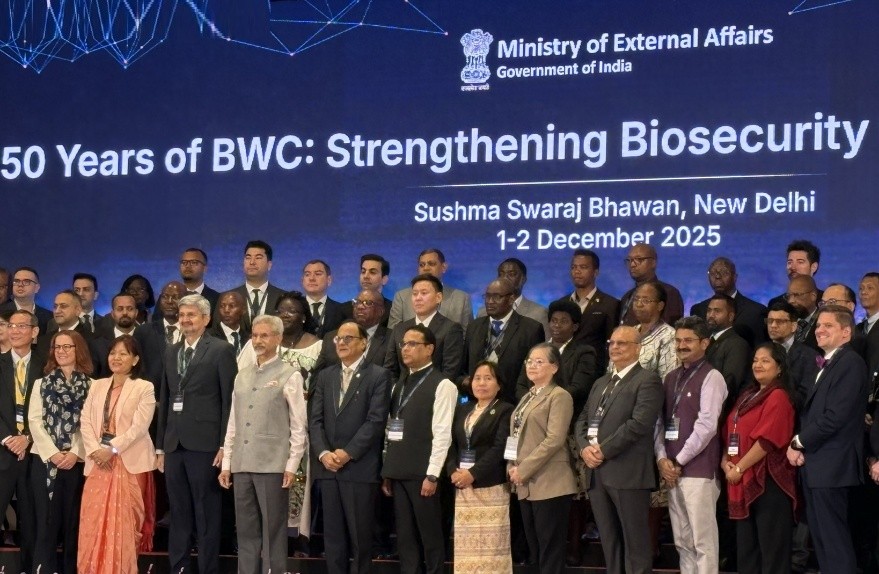India’s Slower Warming: A Climate Puzzle Explained
Introduction – India’s Slower Warming
Global warming means that Earth’s average temperature is rising because of human activities, like burning fossil fuels and cutting down forests. However, this warming does not happen evenly across the world. Some places warm faster, like the Arctic, while others, like India, warm more slowly. India’s average temperature has risen by 0.7°C since 1900, compared to the global land average of 1.59°C. But this does not mean India is safe from climate change. It faces unique challenges because of this warming pattern. This essay explores why India is warming more slowly, the science behind it, and its effects on the environment and people.
India’s Unique Temperature Trends
India’s climate is influenced by its tropical location, surrounded by oceans and rich in diverse landscapes. Scientists have studied the temperature changes across the country from 1901 to 2003. They found that while daytime temperatures (Tmax) increased by 0.743°C per century, nighttime temperatures (Tmin) rose more slowly, at just 0.224°C per century. This difference, called the diurnal temperature range (DTR), has increased by 0.52°C per century in India. Unlike other parts of the world, where nighttime temperatures often rise faster than daytime ones, India’s unique pattern is due to several factors like cloud cover, aerosols (tiny particles in the air), and seasonal changes.
Why India is Warming Slower
Several natural and human-made factors contribute to India’s slower warming.
- India’s Position on the Globe
India is located near the equator in a region called the tropics. Places near the equator warm more slowly than areas closer to the poles. This happens because heat from the tropics moves towards the poles through wind and ocean currents. Additionally, the Arctic is warming about twice as fast as the rest of the world because melting ice exposes land and water, which absorb more heat. India’s tropical location, where the oceans cool the atmosphere, helps to moderate its warming.
- The Role of Aerosols
Aerosols are tiny particles floating in the air. They can come from natural sources like dust or human activities such as burning coal, vehicles, and factories. Aerosols reflect sunlight, reducing the heat that reaches the ground. This “cooling effect” slows down warming in India. However, this comes with a cost. Aerosols also cause air pollution, which harms human health. As India works to reduce pollution, warming might accelerate because fewer aerosols will block sunlight.
- Clouds and Rainfall
Clouds and rain are vital for controlling temperatures. Clouds reflect sunlight during the day, keeping temperatures lower. They also trap heat at night, preventing it from escaping. Studies show that cloud cover in India has decreased over the years, especially during the monsoon season. Less cloud cover means hotter days and cooler nights, which widens the DTR. Similarly, reduced rainfall affects cooling during the day because there is less moisture in the soil to evaporate, which usually helps to cool the air.
How Seasons Impact Warming
India experiences different warming trends across its four seasons: winter, pre-monsoon, monsoon, and post-monsoon.
- Winter (December to February)
Winter has seen the fastest warming in India. Daytime temperatures in winter increased by 1.043°C per century, while nighttime temperatures rose by 0.377°C. The larger rise in daytime temperatures has made winters feel warmer than they used to be. This is concerning because it affects crops like wheat, which depend on cooler winters.
- Pre-Monsoon (March to May)
The pre-monsoon season is also warming, but not as quickly as winter. This period shows significant increases in daytime temperatures, driven by reduced cloud cover and soil moisture. These changes make the hot summer months even harder to bear for people and animals.
- Monsoon (June to September)
Interestingly, the monsoon season has seen the least warming. Nighttime temperatures during this season have even slightly decreased. This cooling effect, combined with moderate daytime warming, helps to balance India’s overall temperature rise. However, reduced rainfall during the monsoon has caused problems like water scarcity and lower crop yields.
- Post-Monsoon (October to November)
Post-monsoon temperatures have also increased significantly. Both daytime and nighttime temperatures are rising, with reduced cloud cover contributing to higher daytime heat. This trend could disrupt farming cycles and natural ecosystems that rely on predictable weather.
Effects of Slower Warming on India
Although India is warming more slowly, this does not mean it is less affected by climate change. The unique warming pattern has its own set of challenges.
- Agricultural Impacts
The widening gap between day and night temperatures (increased DTR) can harm crops. For instance, crops like rice and wheat need stable temperatures to grow. Warmer days and cooler nights can disrupt their growth cycles, reducing yields. Farmers also struggle with unpredictable weather patterns, like irregular rainfall during the monsoon.
- Water Resources
India depends heavily on monsoon rains for its water supply. As rainfall patterns shift, water availability becomes uncertain. Hotter days increase evaporation, worsening water shortages. This impacts drinking water, farming, and hydroelectric power generation.
- Health and Livelihoods
Warmer days and more frequent heatwaves make life harder, especially in cities. Urban areas absorb more heat because of concrete buildings and asphalt roads, creating “heat islands.” This puts people, especially outdoor workers, at risk of heat-related illnesses. Cooler nights during the monsoon may offer temporary relief but do little to mitigate the overall discomfort.
- Biodiversity at Risk
Many animals and plants depend on stable temperatures to survive. Changes in DTR affect wildlife by altering habitats and food sources. For example, warmer days can dry up water bodies, affecting aquatic life. Shifts in flowering and fruiting seasons disrupt food chains.
Why It Is Not Time to Relax
India’s slower warming might seem like good news, but it does not mean the country is safe. The factors currently slowing warming, like aerosols and cloud cover, are not permanent solutions. As India cleans up its air and develops further, the warming trend could speed up. This would bring more severe heatwaves, water shortages, and crop failures.
Learning from India’s Climate Story
India’s unique climate patterns teach us valuable lessons about global warming. They show how local factors like geography, pollution, and rainfall affect temperature trends. This highlights the need for solutions tailored to specific regions instead of a one-size-fits-all approach. For example, protecting forests, managing water resources, and improving urban planning can help India adapt to its changing climate.
Conclusion
India’s slower warming is a result of its tropical location, high aerosol levels, and seasonal weather patterns. While this provides some temporary relief from the rapid warming seen in other parts of the world, it also brings unique challenges like rising DTR, shifting monsoon patterns, and risks to agriculture and biodiversity. Addressing these issues requires urgent action, from reducing air pollution to adapting farming practices and conserving water.
As one of the world’s largest countries, India plays a crucial role in global climate efforts. Its story reminds us that climate change affects everyone differently, but solving it requires us to work together. By understanding and acting on these lessons, we can help protect not just India but the entire planet from the threats of climate change.
Subscribe to our Youtube Channel for more Valuable Content – TheStudyias
Download the App to Subscribe to our Courses – Thestudyias
The Source’s Authority and Ownership of the Article is Claimed By THE STUDY IAS BY MANIKANT SINGH





